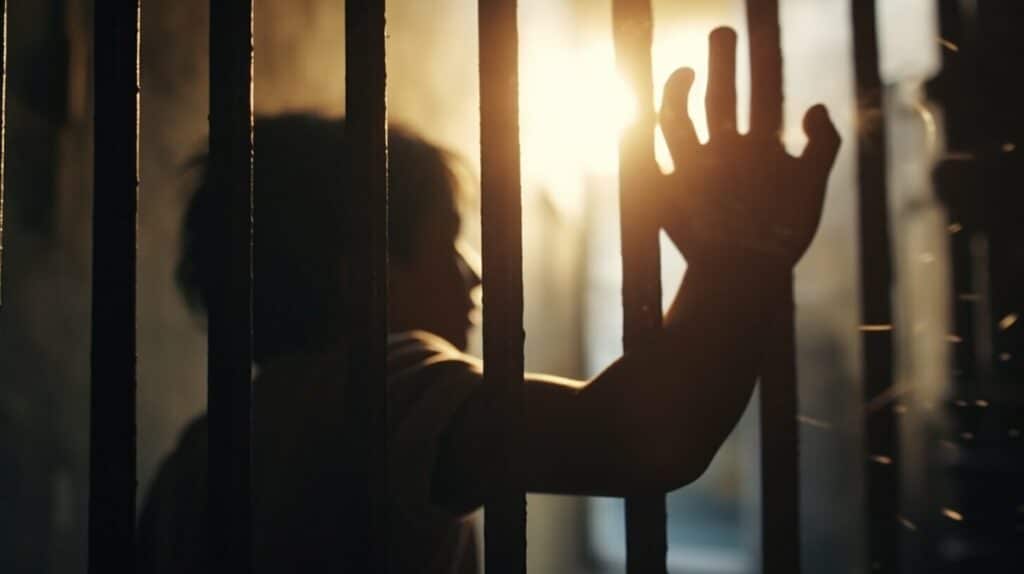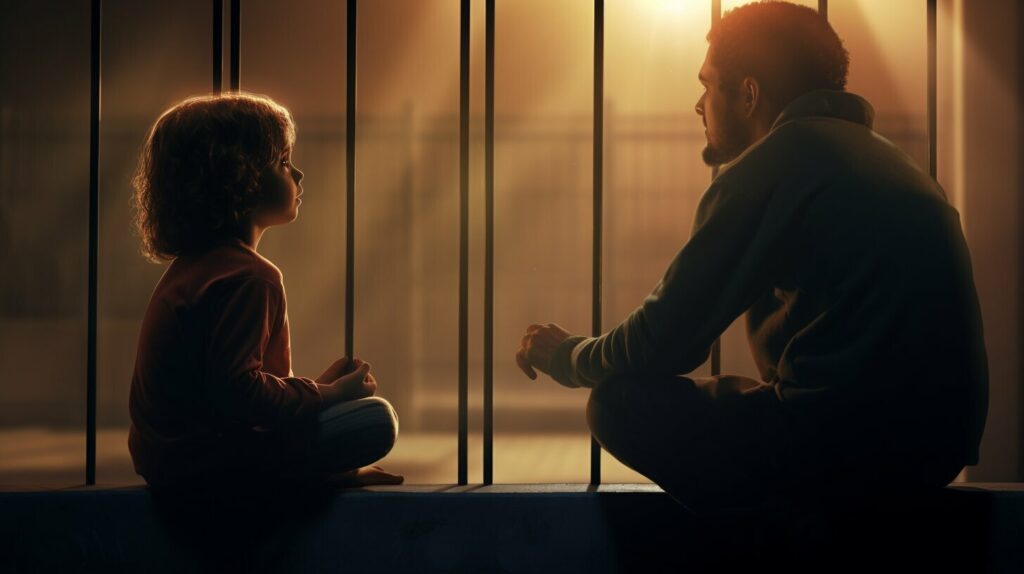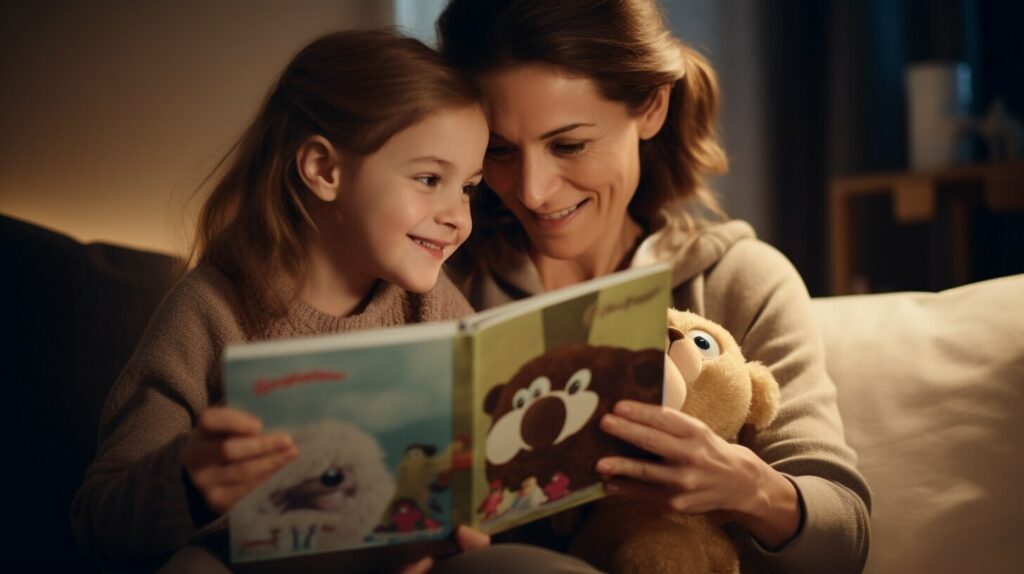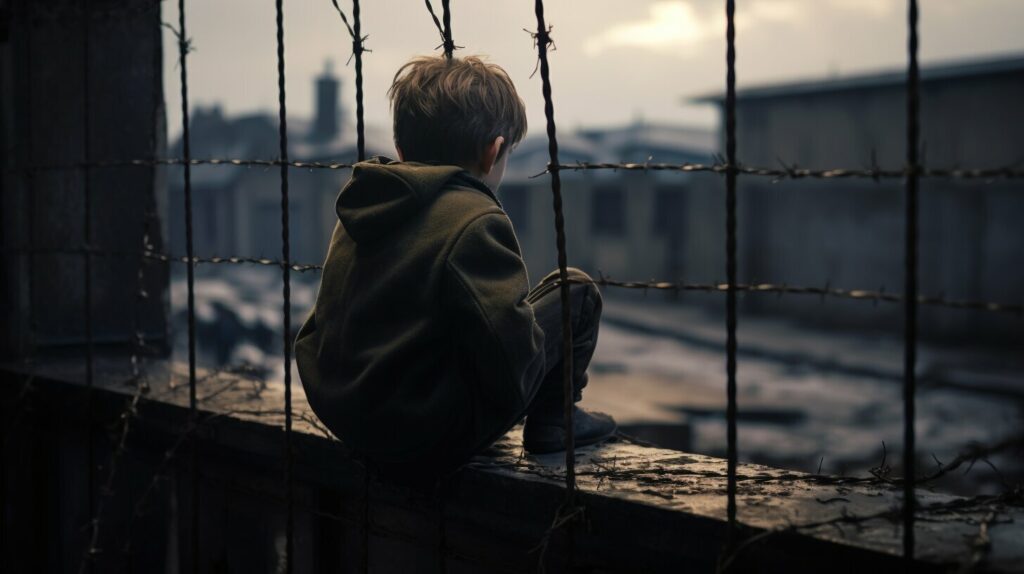Explaining difficult topics to children can be challenging, but it’s important to have open and honest communication with them. When it comes to discussing incarceration, it’s essential to tailor your explanation to fit your child’s age and level of understanding. In this section, we’ll provide you with tips and guidance on how to approach the topic of incarceration with your child in a child-friendly way.
Key Takeaways:
- Open and honest communication is essential when discussing incarceration with children.
- It’s important to tailor your explanation to fit your child’s age and level of understanding.
- Child-friendly explanations can help children understand difficult topics in a way that they can comprehend.
Why it’s Important to Discuss Incarceration with Kids
When a loved one is incarcerated, it can be a difficult and emotional time for everyone involved. Children, in particular, may have a lot of questions and concerns about what is happening and why.
It’s important to address these questions and provide age-appropriate explanations about incarceration and the justice system. By doing so, you can support your child’s emotional well-being and help them understand what is happening to their loved one.
Avoiding the topic of incarceration can lead to confusion, fear, and stigma. By having an open and honest conversation, you can help your child process their emotions and reduce any negative impact on their mental health.
Furthermore, discussing incarceration with your child can help them develop empathy and understanding towards individuals who are incarcerated. This can reduce stigmatization and help promote a more compassionate society.
Overall, discussing incarceration with your child is an important step in supporting their emotional well-being and fostering a better understanding of the justice system.

Understanding Incarceration: Breaking It Down for Kids
Explaining incarceration to a child can be challenging, but it’s important to provide them with age-appropriate information and answer their questions honestly. To help kids understand prison, it’s important to break down the concept into simple terms and avoid using complex legal language.
First, explain that when people break the law, they may have to go to jail or prison as a punishment. Tell them that jail is a place where people who have been accused of a crime go to stay until their trial, while prison is a place where people go if they are found guilty and have to serve a longer sentence.
| Tip: | Use examples that children can relate to, such as a time-out or being grounded, as a way to explain the purpose of incarceration. |
|---|
It’s also important to emphasize that the people who are in prison are still human beings and have feelings just like everyone else. Help your child understand that bad choices and mistakes do not define a person’s worth or value as a human being.
By breaking down incarceration into simple terms and emphasizing empathy and understanding, you can help your child navigate an emotional and complex topic.

Explaining the Justice System to a Child
Explaining the justice system to a child can feel overwhelming. However, breaking it down into simpler terms can make it easier for them to understand.
Start by explaining that laws are in place to protect people and keep them safe. When someone breaks a law, they are punished. Punishments can include a fine, community service, or even being sent to jail. Jail is a place where people who break serious laws go to stay.
| Important concepts to cover: | How to explain them: |
|---|---|
| Arrest | When someone is accused of breaking the law, the police may arrest them. This means they are taken to a police station and kept there for a short time while they are questioned. If they are found guilty of breaking the law, they may be punished. |
| Trial | When someone is accused of breaking the law, they go to court. During a trial, a judge and jury listen to the facts and decide if the person is guilty or innocent. |
| Sentence | If someone is found guilty, they are given a sentence. This is the punishment they will receive for breaking the law. The sentence can be different for each person, depending on how serious the crime was. |
It’s important to note that not everyone who goes to jail is a bad person. Sometimes people make mistakes and have to face the consequences of their actions. However, it’s never okay to hurt others or break the law.
By explaining the justice system in a way that is age-appropriate and easy to understand, you can help your child make sense of the situation and feel more secure.

Approaching the Conversation: Tips for Parents
When it comes to discussing incarceration with your child, it’s important to approach the conversation with care and consideration. Here are some tips to help you navigate this sensitive topic:
1. Be Honest and Direct
Children are perceptive and can often sense when something is being kept from them. It’s important to be honest and direct when explaining the situation to your child. Use age-appropriate language, but don’t avoid the truth.
2. Listen to Their Concerns
Allow your child to express their feelings and concerns. Listen carefully and validate their emotions. This can help your child feel more supported and understood.
3. Provide Reassurance
Let your child know that they are not alone and that they will be taken care of. Provide reassurance and comfort, and remind them that they are loved.
4. Keep the Conversation Open
It’s important to keep the lines of communication open with your child. Encourage them to ask questions or express their feelings whenever they need to.
5. Seek Support When You Need It
Dealing with incarceration can be challenging for both you and your child. Don’t be afraid to seek support from trusted friends, family members, or professionals if you need it.

Remember, explaining incarceration to a child is a difficult but necessary conversation. By being honest, listening to their concerns, and providing ongoing support, you can help your child navigate this challenging time and emerge stronger and more resilient.
Age-Appropriate Explanations: Tailoring the Message
When talking to a child about incarceration, it’s important to tailor your explanation to their age and level of understanding. While older children may be able to handle more complex concepts and terminology, younger children will require simpler explanations and age-appropriate language.
For younger children, try using simple language and concrete examples they can relate to. For example, you might explain that someone who does something against the law might have to go to a special place for a while.
Older children may be able to understand more abstract concepts and legal terminology. You can use the opportunity to discuss the legal system and how it works, breaking down the steps involved in a trial and explaining the differences between a judge and a jury.
Remember to use reassuring language and emphasize that the incarceration is not the child’s fault. Children may feel a sense of shame or guilt when a loved one is incarcerated, so it’s important to provide emotional support and let them know that it’s okay to have questions and feelings about the situation.

As children grow and develop, their understanding of incarceration and the justice system will evolve. Be prepared to revisit the topic periodically and adjust your explanations as needed.
Answering Questions and Addressing Emotions
Explaining incarceration to a child can bring up difficult emotions and a lot of questions. It’s important to create a safe and supportive environment where children feel comfortable asking questions and expressing their feelings. Here are some tips on how to address their concerns:
- Encourage questions: Let your child know that they can ask anything they want and that you will do your best to answer honestly and age-appropriately.
- Validate their emotions: Children may feel a range of emotions, including sadness, anger, fear, or confusion. Let them know that their feelings are normal and that it’s okay to feel that way.
- Provide reassurance: Children may worry about their safety, the safety of the incarcerated loved one, or the future of their family. Offer reassurance and emphasize that you are there to support them through this difficult time.
It’s important to be patient and understanding when answering questions and addressing emotions. Avoid being dismissive or judgmental, and try to avoid using language that could further stigmatize incarceration or the justice system.
“Remember to listen more than you talk. Asking open-ended questions like ‘What do you think about that?’ or ‘How does that make you feel?’ can encourage children to express themselves and help you understand where they’re coming from.
Be prepared to have ongoing conversations with your child about incarceration and offer ongoing emotional support as needed.

Supporting the Child: Coping Strategies and Resources
Dealing with the incarceration of a loved one can be overwhelming for children and cause a range of difficult emotions. As a parent or caregiver, it’s essential to provide ongoing support and guidance to help them cope with the situation.
One coping strategy is to encourage children to express their feelings and emotions. Let them know that their feelings are valid and offer a safe and supportive environment for them to talk about their worries or concerns.
Seeking professional support can also be beneficial. Consider enrolling your child in counseling or therapy sessions to help them process their emotions and develop coping skills. There are also support groups specifically for children of incarcerated parents that can provide them with additional resources and a supportive community.
Another helpful resource is age-appropriate books or materials that can help children understand and cope with the situation. Here are a few to consider:
| Book Title | Author |
|---|---|
| Visiting Day | Jacqueline Woodson |
| My Daddy Is in Jail | Janet M. Bender |
| Far Apart, Close in Heart: Being a Family When a Loved One is Incarcerated | Becky Birtha |
These books can help children understand the complex emotions associated with having a loved one in jail and can offer strategies for coping with their feelings.

Remember, providing emotional support and resources is essential for helping children cope with the challenges associated with incarceration. By helping them develop coping skills and fostering open communication, you can help them navigate this difficult time with resilience and strength.
Building Resilience: Teaching Empathy and Understanding
Helping children understand incarceration requires empathy and understanding towards individuals who are in jail. It’s important to foster compassion and reduce stigmatization of those who are incarcerated, and this starts with educating children about the realities of prison. By doing so, you can help build resilience and understanding among children who may be struggling with the emotional impact of having a loved one in jail.
Encourage your child to be empathetic towards individuals who are in prison. Explain that people make mistakes and that everyone deserves a second chance. Talk about how everyone has the potential to change, and that individuals who are incarcerated can work towards rehabilitation and transformation.
At the same time, it’s important to be honest about the consequences of committing a crime and the importance of taking responsibility for one’s actions. Use age-appropriate language to describe the consequences of breaking the law, but emphasize that incarceration is not the only solution.
Consider using educational resources to teach your child about empathy and understanding. Check out books or documentaries that explore the experiences of people who are incarcerated or have been impacted by the criminal justice system. This can help your child see the human side of the issue and develop a more nuanced perspective.

Navigating Visitations and Maintaining Relationships
Visiting a loved one in jail can be a daunting experience for both children and adults. However, maintaining strong relationships with incarcerated family members is crucial for their well-being and can help children feel a sense of connection and support during a difficult time.
Before visiting, it’s important to prepare your child for what to expect. Explain the security measures they’ll encounter, such as metal detectors and pat-downs, and let them know that they won’t be able to bring in certain items like food or toys. Encourage them to ask questions and share their feelings about the visit.
During the visit, try to focus on positive topics and activities, such as sharing family news or playing games. Remind your child that their loved one still cares for them, even though they’re not able to be together outside of jail. If your child expresses negative emotions, validate their feelings and offer support.
| Tip: | Consider bringing a snack or activity to share during the visit, such as coloring books or playing cards. This can help ease tension and make the experience more enjoyable for both you and your child. |
|---|
It’s also important to maintain communication outside of visitations. Encourage your child to write letters or draw pictures to send to their loved one, or set up phone calls or video chats if possible. This can help maintain the bond between the child and their incarcerated family member.
| Tip: | Keep letters and pictures positive and uplifting, focusing on happy memories or future plans. Avoid discussing negative aspects of the incarceration or legal proceedings. |
|---|
If your child is struggling with the emotional impact of having a loved one in jail, consider seeking support from a counselor or support group. These resources can help children process their emotions and provide coping strategies for dealing with the challenges of the situation.

Helping Children Cope: Emotional Support and Reassurance
Discussing incarceration with children can be a difficult and emotional process. As a parent, it’s important to provide ongoing emotional support and reassurance to help your child cope. Here are some strategies that may be useful:
- Encourage discussion: Let your child know that it’s okay to talk about their feelings and concerns. Reassure them that they’re not alone, and that you’re there to listen and support them.
- Validate their emotions: Let your child know that it’s normal to feel sad, angry, or confused about the situation. Avoid dismissing or downplaying their emotions, as this can make them feel isolated and unheard.
- Provide age-appropriate explanations: Use language and concepts that your child can understand, and avoid overwhelming them with too much information at once. Break the information down into small, manageable pieces, and be patient as they process the information.
- Offer reassurance: Remind your child that they are loved and supported, and that the situation is not their fault. Encourage them to focus on positive memories and experiences, and to stay connected with friends and other family members.
Remember, every child copes with incarceration differently, and there’s no one “right” way to approach the situation. Be patient, supportive, and open to your child’s needs, and seek out professional support if necessary. By providing ongoing emotional support and reassurance, you can help your child navigate this difficult time and emerge stronger and more resilient.

Conclusion
Congratulations! You’ve now reached the end of this article, which has hopefully provided you with some valuable insight into how to explain incarceration to a child.
Remember, open and honest communication is key when discussing this complex topic. Always tailor your explanation to suit the child’s age and level of understanding, and be sure to answer any questions or concerns they may have.
Final Thoughts
While discussing incarceration with a child can be challenging, it is also an opportunity to help them develop empathy and understanding towards individuals who may have made mistakes in their lives. By providing ongoing emotional support and reassurance, you can help your child navigate this difficult time and maintain a strong, positive relationship with their loved one.
Don’t forget to take advantage of available resources such as counseling services and support groups, and always keep the lines of communication open with your child. With patience, understanding, and compassion, you can help your child cope with the challenges of incarceration and emerge stronger and more resilient as a result.
Can the Same Methods be Used to Explain Hopeful and Incarceration to a Child?
When it comes to explaining hopeful ideas and incarceration to children, different approaches are needed. While positive reinforcement, encouragement, and optimism can be utilized for hopeful children, explaining incarceration necessitates a delicate balance of honesty, simplicity, and empathy. Tailoring the explanation methods for hopeful children ensures they understand both concepts without causing confusion or unnecessary distress.
FAQ
Q: How do I explain incarceration to a child?
A: When explaining incarceration to a child, it’s important to be open and honest. Tailor the explanation to their age and level of understanding, using language they can comprehend.
Q: Why is it important to discuss incarceration with kids?
A: Discussing incarceration with kids is important because it helps address their questions and concerns directly. It can also help them cope with the emotional impact of having a loved one in jail.
Q: How can I help kids understand prison?
A: To help kids understand prison, break down the concept of incarceration in child-friendly terms. Explain what it means and how it differs from other forms of punishment.
Q: How do I explain the justice system to a child?
A: When explaining the justice system to a child, simplify complex legal processes and terminology. Focus on key elements that they can comprehend and relate to incarceration.
Q: How should I approach the conversation about incarceration with my child?
A: When approaching the conversation about incarceration, be supportive and informative. Provide practical tips and guidance for addressing their questions and concerns.
Q: How do I tailor the message of incarceration to my child’s age?
A: Tailoring the message of incarceration to your child’s age is important. Use age-appropriate language and explanations that match their developmental stage.
Q: How do I answer questions and address emotions about incarceration?
A: When answering questions about incarceration, be honest and supportive. Address their emotions by providing reassurance and understanding.
Q: How can I support my child coping with the incarceration of a loved one?
A: Support your child coping with the incarceration of a loved one by offering coping strategies and resources. This can include support groups, counseling services, and age-appropriate books or materials.
Q: How do I teach empathy and understanding to my child?
A: Teach empathy and understanding to your child by discussing the importance of compassion and reducing stigmatization towards individuals who are incarcerated.
Q: How can I navigate visitations and maintain relationships during incarceration?
A: To navigate visitations and maintain relationships during incarceration, provide advice on preparing children for visitations and addressing their fears or concerns.
Q: How can I provide emotional support and reassurance to my child?
A: Provide emotional support and reassurance to your child by creating a safe and nurturing environment. Help them cope with the challenges associated with incarceration.
Q: Conclusion
Summarize the key points covered in the article and emphasize the importance of open and honest communication when explaining incarceration to a child. Reinforce the need to provide age-appropriate explanations, address questions and emotions, and offer ongoing support to help children navigate this complex topic.






